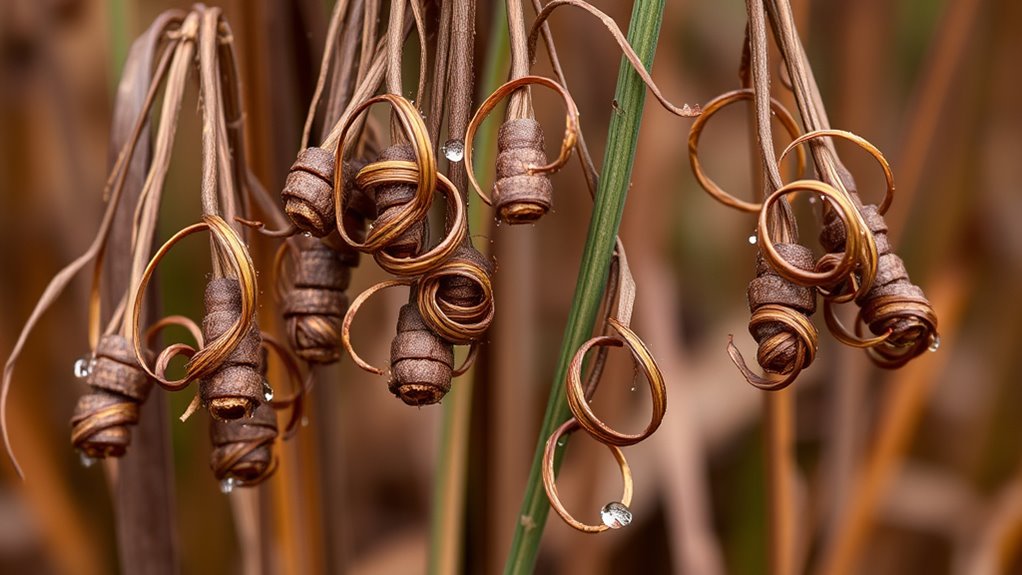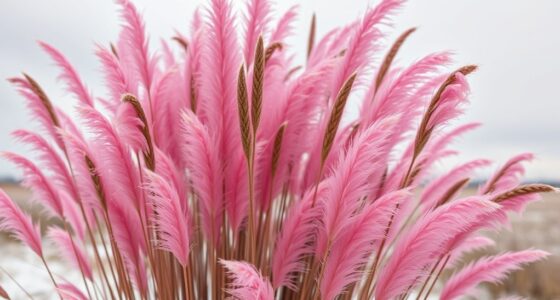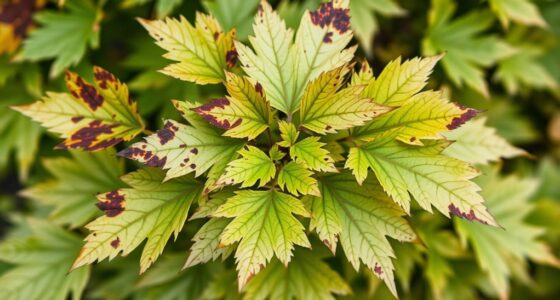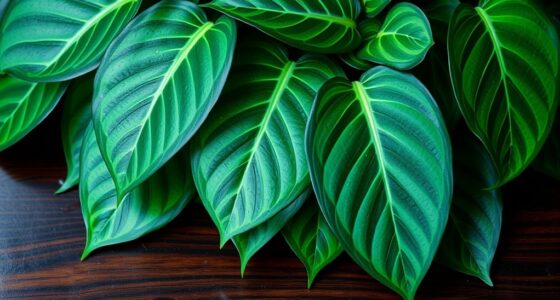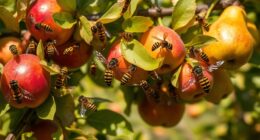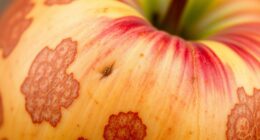If your corkscrew rush turns brown, it could be a sign of seasonal dormancy or a health issue. During dormancy, the plant naturally fades and looks less vibrant, but stems stay stiff, and growth slows. Disease or pests usually cause uneven browning, soft stems, or spots on the foliage. To tell the difference and keep your plant healthy, consider its care and symptoms; further details can help you make the right move.
Key Takeaways
- Brown tips during dormancy are natural; uniform browning with healthy stems suggests seasonal slowdown.
- Diseased corkscrew rush shows irregular browning, mold, mushy stems, or foul odor, indicating infection.
- Dormant rush stems remain stiff but flexible; disease-affected stems become brittle or overly soft.
- Seasonal browning occurs without spots or mushiness; disease involves spots, mold, or soft, rotting tissue.
- Proper care, including adjusted watering and adequate sunlight, helps distinguish natural dormancy from disease symptoms.
Recognizing the Signs of Seasonal Changes in Corkscrew Rush

As the seasons change, you can notice several telltale signs that your corkscrew rush is shifting into its brown, dormant phase. You might see the plant’s foliage turn from vibrant green to a more subdued, brownish hue. This is a natural part of its seasonal cycle, signaling dormancy rather than disease. During this time, avoid over-fertilizing; instead, apply a balanced fertilizer to support healthy growth when the season shifts again. Pruning practices should be minimal now—remove only dead or damaged leaves to keep the plant tidy. Do not cut back severely, as this can stress the plant further. Recognizing these signs helps you differentiate between seasonal dormancy and potential problems, ensuring your corkscrew rush remains healthy through the changing months. Additionally, understanding seasonal dormancy can help you better care for your plant during its natural cycle. Being aware of plant health indicators allows for timely intervention if issues arise outside of normal dormancy.
Common Disease Symptoms Affecting Corkscrew Rush

While corkscrew rush is generally resilient, it can sometimes develop disease symptoms that threaten its health. Fungal infections are common culprits, causing brown or black spots on leaves, mold, or slimy patches. You might notice the plant becoming mushy or developing a foul odor if the infection progresses. Nutrient deficiencies also present symptoms, such as pale or yellowing foliage, weak stems, and stunted growth. These deficiencies often result from poor soil conditions or improper fertilization. Understanding plant health indicators can help you maintain optimal conditions for your plant’s vitality. Recognizing these symptoms early helps you take corrective actions, like improving drainage, applying fungicides, or adjusting fertilization, to restore your corkscrew rush’s health. Additionally, paying attention to soil quality is essential, as it directly influences nutrient uptake and overall plant resilience. Improving soil drainage and aeration can prevent moisture buildup that fosters fungal growth and promotes healthier roots.
Comparing Growth Patterns in Dormant and Diseased Plants
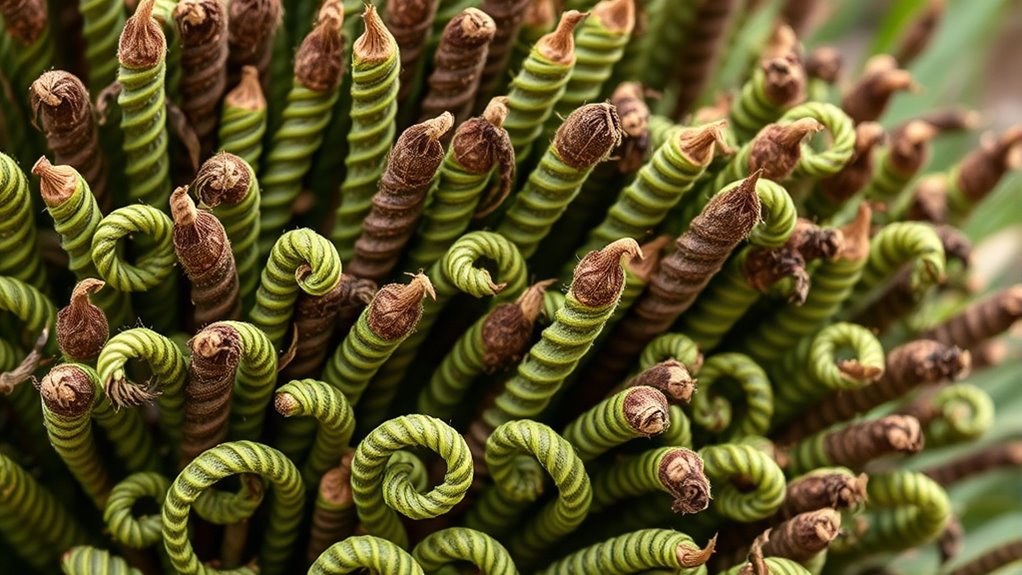
You’ll notice that dormant plants often have duller leaf colors compared to healthy ones, while diseased plants may show irregular color changes. The flexibility of stems also differs, with dormant plants maintaining stiffness and diseased plants becoming brittle or overly soft. Additionally, growth rates slow down markedly in both cases, but diseased plants sometimes exhibit abnormal growth patterns that stand out. Recognizing the signs of seasonal dormancy can help distinguish these from disease symptoms. Monitoring these plant health indicators can aid in early detection and appropriate care. Being aware of plant stress responses can further improve diagnosis accuracy.
Leaf Color Changes
When observing corkscrew rushes, changes in leaf color can reveal whether the plant is simply dormant or suffering from disease. Foliage discoloration during dormancy usually appears as a natural fading to duller shades without extensive spotting or streaks. In contrast, disease often causes irregular or rapid leaf color changes, such as yellowing, browning, or black spots. Nutrient deficiency can also lead to leaf discoloration, usually showing as uniform yellowing or pale areas across the foliage. If the discoloration is consistent and gradual, your plant might be dormant, awaiting better conditions. However, sudden or uneven color changes, especially with accompanying spotting or wilting, often indicate disease or nutrient issues that require prompt attention. Recognizing these differences helps you diagnose and manage your corkscrew rush effectively. Additionally, plant health monitoring techniques can assist in early detection of issues before they become severe, and understanding growth patterns can further aid in distinguishing dormancy from disease.
Stem Flexibility Differences
Stem flexibility offers a clear clue to the health of your corkscrew rush. In healthy, dormant plants, the stems tend to be more flexible, showing less stem rigidity, and the root elasticity remains high. This flexibility allows the stems to bend without snapping, indicating strong cellular structure and overall robustness. Proper plant maintenance can help ensure your rush stays healthy and resilient. Conversely, if your rush is diseased, you’ll notice increased stem rigidity and decreased root elasticity, making the stems brittle and prone to breaking. These changes suggest internal tissue damage and weakened structural integrity. By carefully observing how your plant responds to gentle manipulation, you can distinguish healthy growth from potential disease. Flexibility is a key indicator—healthy stems bend easily, while diseased ones feel stiff and fragile. Additionally, proper maintenance and inspection of your plant can help prevent disease and promote resilience.
Growth Rate Variations
Healthy corkscrew rushes typically maintain a steady growth rate, with new stems emerging gradually and consistently over time. During seasonal dormancy, growth slows considerably, and new shoots may stop altogether. In contrast, diseased plants affected by root rot or fertilizer deficiency often show uneven growth patterns, with some areas appearing stunted or dying back. This variation can signal underlying issues. Here’s a comparison: You can also assess plant health indicators to determine the specific cause of growth irregularities. Additionally, monitoring environmental conditions can help distinguish between natural dormancy and disease-related decline. Recognizing these growth patterns early can prevent further damage and promote healthier plant development.
Proper Care Tips During Dormancy Periods

During dormancy periods, it’s essential to reduce watering and avoid fertilizing your corkscrew rush. This helps prevent overwatering and encourages the plant to rest. When pruning during this time, use gentle techniques to remove dead or damaged leaves, making clean cuts just above the base. Avoid heavy pruning, as it can stress the plant further. Adjust your fertilizer schedule by halting fertilization until new growth begins in the spring. Focus on maintaining proper moisture levels without overdoing it. Keep the plant in a cool, shaded location if possible, and ensure it’s protected from harsh conditions. Proper care during dormancy helps your corkscrew rush recover and prepares it for healthy growth when the season changes. Additionally, understanding seasonal dormancy can aid in distinguishing between natural browning and disease-related damage. Recognizing plant health indicators can also help you identify early signs of potential issues and address them promptly. Being aware of seasonal changes can facilitate better timing for care adjustments and prevent unnecessary concern.
Preventative Measures to Keep Your Corkscrew Rush Healthy

To keep your corkscrew rush healthy, you need to focus on proper watering, ensuring it stays moist but not soggy. Make sure it gets enough sunlight to promote vibrant growth, and regularly check for pests that could cause damage. Taking these preventative steps helps your plant stay strong and resist browning. Be aware of symptoms of stress or disease to catch any issues early and maintain your plant’s health. Maintaining appropriate plant care practices is essential for preventing seasonal dormancy from turning into health problems.
Proper Watering Techniques
Wondering how to keep your corkscrew rush vibrant and thriving? The key is establishing a consistent watering schedule that maintains proper soil moisture. Avoid letting the soil dry out completely, as this stresses the plant and can cause browning. At the same time, don’t overwater, which can lead to root rot and fungal issues. Check soil moisture regularly by touching the top inch; it should feel damp but not soggy. During active growing seasons, you might need to water more frequently, especially if the weather is hot and dry. In cooler months or dormancy, cut back on watering but ensure the soil stays slightly moist. Proper watering habits promote healthy growth and help prevent browning caused by drought stress or overwatering.
Adequate Sunlight Exposure
Ensuring your corkscrew rush receives adequate sunlight is essential for maintaining its vibrant, healthy appearance. Sunlight encourages strong growth and helps prevent browning caused by seasonal dormancy or disease. To optimize sunlight exposure, use appropriate pruning techniques to remove dead or damaged foliage, allowing more light to reach the healthy parts of the plant. Proper pruning also promotes air circulation, reducing the risk of disease. Additionally, soil nutrition plays a crucial role; well-fed plants are better equipped to utilize sunlight efficiently. Position your rush in a spot where it receives full or partial sun, ideally at least four hours daily. Consistent sunlight, combined with proper pruning and nutrient-rich soil, keeps your corkscrew rush thriving and minimizes browning issues.
Regular Pest Inspection
Regular pest inspection is an essential step in keeping your corkscrew rush healthy and free from damage. By routinely checking for pests like aphids or scale insects, you can catch problems early and prevent infestations that weaken the plant. Pest prevention starts with monitoring, but applying a suitable fertilizer also boosts your rush’s natural defenses, making it less vulnerable to pests. During inspections, look for sticky residue, discolored or damaged leaves, and unusual insects. If you spot pests, treat promptly with insecticidal soap or neem oil. Consistent pest inspection combined with proper fertilizer application helps maintain the plant’s vigor, reducing disease risk and ensuring your corkscrew rush stays lush and healthy year-round.
When to Seek Professional Help for Your Corkscrew Rush

If your corkscrew rush begins to turn brown despite proper care, it’s a clear sign that you should consider consulting a professional. You might be dealing with root rot, pest infestation, or other underlying issues. Here are four signs it’s time to seek help:
- Persistent browning despite adjusting watering habits
- Soft, mushy roots or a foul odor indicating root rot
- Visible pests or unusual spots on leaves
- No improvement after treatments or repotting efforts
A professional can diagnose problems accurately and recommend targeted solutions. Addressing root rot early prevents plant loss, while expert pest control keeps your rush healthy. Don’t hesitate to get professional advice when your corkscrew rush shows these warning signs.
Frequently Asked Questions
Can Environmental Stress Cause Corkscrew Rush to Turn Brown Unexpectedly?
Environmental triggers can indeed cause your corkscrew rush to turn brown unexpectedly. Stress from factors like extreme temperatures, drought, or overwatering can impact the plant’s health. Pest identification is also vital, as pests can weaken the plant and cause discoloration. By monitoring environmental conditions and inspecting for pests regularly, you can address issues early and help your corkscrew rush recover, keeping it healthy and vibrant.
How Long Does Seasonal Dormancy Typically Last in Corkscrew Rush?
Think of seasonal dormancy as nature’s pause button for your corkscrew rush. Typically, the dormancy duration lasts about 2 to 3 months, during which the plant conserves energy and sheds its vibrant seasonal color. This period varies with climate and growing conditions, but you can expect your rush to wake up and regain its color once warmer weather returns. Patience helps your plant emerge revitalized.
Are There Specific Fertilizers to Prevent Disease in Corkscrew Rush?
You should choose fertilizers with balanced nutrients like nitrogen, phosphorus, and potassium to promote healthy growth and help prevent disease. Look for fertilizers labeled specifically for ornamental grasses or rushes, as these support disease resistance. Proper fertilizer selection strengthens your corkscrew rush’s immune system, reducing the risk of infections. Remember to apply fertilizer according to package instructions, avoiding over-fertilizing, which can make your plant more susceptible to diseases.
What Are the Risks of Mistaking Disease for Natural Seasonal Color Change?
You risk mistaking disease for natural seasonal color change when you don’t closely observe your corkscrew rush. During winter dormancy, the plant naturally turns brown or fades, which can resemble disease symptoms. However, if the browning persists beyond dormancy or is accompanied by unusual spots or mold, it’s likely disease. Recognizing the difference helps you take timely action and avoid unnecessary treatments that could harm your plant.
How Can I Differentiate Between Minor Damage and Serious Health Issues?
Think of your corkscrew rush as a patient on a health journey. To tell minor damage from serious issues, look for signs like pest infestations or soil imbalance. Minor damage may cause some browning but leaves stay healthy overall. Serious health problems often show widespread browning, mushy spots, or pests. Regularly inspect your plant closely—quick action can turn the tide before small issues become big disasters.
Conclusion
As you watch your corkscrew rush rush shift with the seasons, remember it’s like a delicate dance between nature’s rhythm and health. By understanding the signs of dormancy versus disease, you’re the steady hand guiding it through each change. With attentive care and love, you’ll help it flourish anew, like a phoenix rising from the ashes. Trust your instincts and nurture your plant’s journey—beautiful, resilient, and full of life’s endless renewal.
